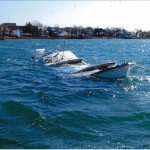Facilitation of a Rescue at Sea
According to Alan Sorum, an unreformed Alaska harbormaster and a member of the USCGAux, there are quite a few things that could happen during a rescue. Basically, you’ll call the Coast Guard or another authority and ask for help.  The most direct method is for the boat in distress to make a May Day call on channel 16 and communicate directly with the Coast Guard. That’s one way.
The most direct method is for the boat in distress to make a May Day call on channel 16 and communicate directly with the Coast Guard. That’s one way.
When placing a May Day call you always start off saying the May Day message three times and then the basic information about your situation. Like this:
May Day, May Day, May Day– then you give the name of your boat, number of people on board, where you’re located, and the nature of your distress.
The Coast Guard should now come back and talk to you. They’ve actually have an entire script where they’ll go through the whole situation with you and nail down all the information they need. The key is to get that first conversation started.
This person answering the phone is known as a watch standard or depending on where the call is received, a search and rescue coordinator that picks up the call. Not a Coast Guard member out on the boat. Patience is definitely a virtue here because whoever answers the phone will be asking a lot of questions.
The reason for so many questions is in case they lose contact with you or something fails later. The point is to load the conversation with as much information as they can about the boat, the situation, where you’re at, etc. Knowledge is definitely safety in that situation. Again, you just have to be patient – take a deep breath and answer as many of the questions as you can.
Be aware of your surroundings
Anytime you’re out on the boat it’s best for one or all of you to pay attention to your surroundings. For example: make a mental note of lighthouses, any landmarks, church steeples, or navigational markers as you go by them. You don’t necessarily need to know the names of these geographic locations just that you passed by them.
On-board radio locator beacons operate in a couple of different modes. The beacon transmits a distress signal, and the search and rescue satellite system picks that up and alerts the search and rescue authority to start a rescue mission.
A lot of times, people will see another boat in distress or they’ll hear something on the radio that concerns them – a third party can turn in a report. Also, if you filed a float plan with the harbormaster or a family member, and you didn’t come back on time, that person can call the Coast Guard and ask that they check up on you.
For the worst situations, the Coast Guard does have radio direction finding capabilities, so to some degree they can pick up a bearing on your boat just based on the VHF radio. But, paying attention to your surroundings is always useful.
Last, but not least, the maximum penalty for making a false distress call is six years in prison, a $5,000 civil fine, a $250,000 criminal fine and reimbursement to the Coast Guard.
http://www.uscg.mil/hq/cg5/cg534/sarfactsinfo/SARisNOjoke.asp
If you like this article, you may also like my kindle book – Search and Rescue an interview with Alan Sorum
